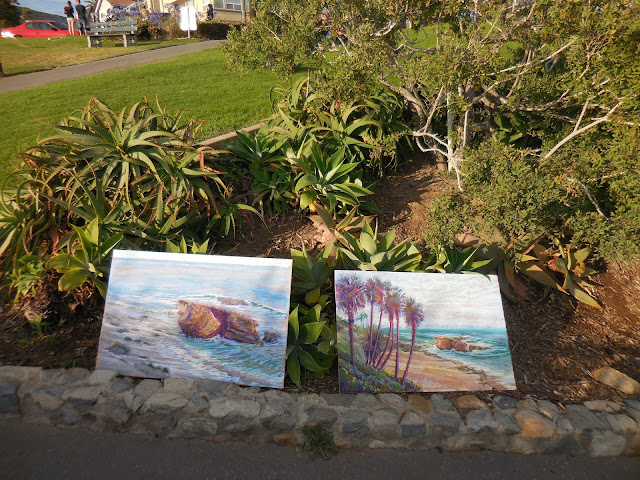 |
 |
| I have painted Heisler Park more than any other subject. It is full of great subjects with iconic beauty. |
I went back to sketching before every painting to warm up. I also went back to sketching to get some extra drawing in and to help work out any compositional issues.
Finding the right spot to paint is always important to me. In this case the shadow would move through the area I was setting up. Trying to be comfortable is critical to the process. On this day I would be painting for over seven hours in the same spot. Simple things like something to drink, a restroom, and some shade make a big difference.
There was a time when I was in a hurry to finish a painting. Like many other plein air artists, I hurried to beat the moving sun. To capture the essence of the scene before the light and shadows and colors all changed.
The realization that everything is changing all the time changed my feelings about hurrying to capture the moment. In every painting the plein air artist is trying to capture a "fleeting moment." As a plein air painter you are acutely aware that everything is changing all the time. Who really captures the "fleeting moment"? At best the artist captures a semi accurate impression of the moment. It isn't because they are a speed painter. They rely on their memory and their experience with studying the form / shape /landscape / in changing light.
The moment is ever changing. What captures the moment is our brain and the memory of what we saw through our particular set of filters. Those filters are the sum of everything we have been influenced by. It is our aesthetic, it is who we are as creators. We then rely on our physical ability to put it down. What image truly reflects the minds image?
When I hear the discussion about painting exactly what we see in front of us as if we were a camera, I have trouble understanding the lack of creativity and imagination needed to do that. Who would want to do this? It seems like copying nature is a soulless activity. I guess there is a sense of accomplishment in the accuracy of technical ability.
The idea of vision as a reflection of the individual's development of their aesthetic through personal symbolism and archetypal experience formation is my personal belief of vision. There is what your eyes see, how your mind interprets it, and how you express that though your artistic spirit, skill, and mind.
So when I hear various artists speaking about the development of being able to see, I think it means understanding yourself and accepting it. Without the confidence to believe in yourself and to trust your vision your expression will be stunted.
Freedom of expression comes from your willingness to put your feelings into your aesthetic expression without fear. If worry finds its way into your expression then it will never reach it's potential. Freedom and confidence encourage risk taking in the creation process. Growth of skill and vision are compounded by freedom of expression and the adventurous spirit. Taking on artistic risks and challenges become exciting when they are seen as a path to a fuller expression. When they are viewed as a way to make mistakes and opportunities to fail growth is limited by fear.
The first painting took about four hours. I put more money in the meter, went to the restroom, got a drink of tea, and started my second painting. It is really easy to loose track of time when painting.
The shape of the painting comes from the reaction of the color on the underpainting. Every color put down changes every other color in succession.
Every color changes the painting and the next color selected. The painting is a chain reaction of color with each influencing the next.
Color as shape. Color as value. Through the development of color relationship within the painting there is a point when the overall tone of the painting is established and it is just a matter of keeping the decision making within the confines of what you have already done. This is the point when you have to trust yourself and the vision you have had for the painting.
At that point the painting really paints itself if you allow it. This is when confidence in your ability allows you to take the painting beyond what you see and allows you to impart your aesthetic vision and feeling into your painting.
Those aspects of your creation process are there throughout the painting, but they are most important and present at the end. It is at that point where you have done everything you can to get it right, that you see the next steps in your development.
As good as you are there is so much more room for improvement. This painting is just another step along the learning curve. When compared to your aspirations and hopes you realize the journey never ends.
A simple painting of a rock in the ocean is just that but so much more. It has taken my whole artistic life to get to that moment. The moments ahead show promise.
The finished painting. 24"X 36" plein air pastel on board with acrylic paint and pumice gel
The days work. Twelve square feet of painting for the day.
The finished painting 24"X 36" plein air pastel on board with pumice gel and acrylic paint.
 |
| The value shot always tells the story if I got the aerial perspective right. In this painting the difference in value between the foreground and background is too similar. |
The value shot.
 |
| The detail shot. |






















No comments:
Post a Comment